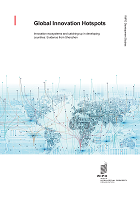Global Innovation Hotspots: Innovation ecosystems and catching-up in developing countries: Evidence from Shenzhen
WIPO Development Studies
Author: Deyun Yin
Author: Jie Tang
Author: Julio Raffo
Publication year: 2022
DOI: English

During the past 40 years, Shenzhen has risen from a fishing village into a globally leading innovation hotspot. What drives such remarkable growth? Is there a “Shenzhen model” for technological catch-up that is different from the classical “Silicon Valley model”? What kind of policy lessons can Shenzhen offer to developing countries and lag-behind regions? Based on international patent and scientific publication data, this report classifies Shenzhen’s technological trajectory and catch-up process into three stages: 1) accessing advanced technology by participating in the Global Production Networks (GPNs) and Global Value Chains (GVCs), 2) accumulating technological knowledge and enhancing absorptive capability through imitation and 3) achieving indigenous innovation. We interpret this remarkable catch-up process from the perspective of 1) technological specialization, 2) the local innovation ecosystem and 3) its embeddedness into the Global Innovation Networks (GINs). The last part summarizes Shenzhen’s policy lessons in fostering innovation-based economic growth in developing countries and areas.
